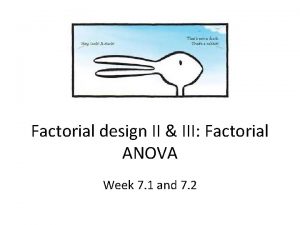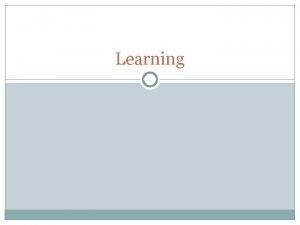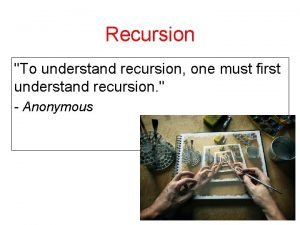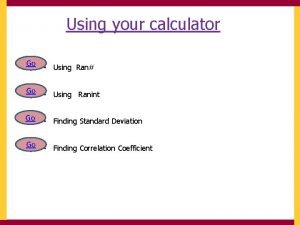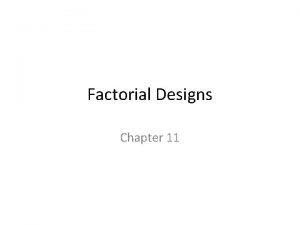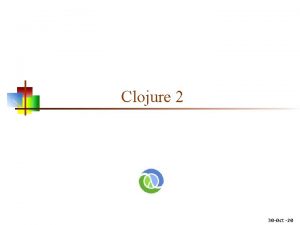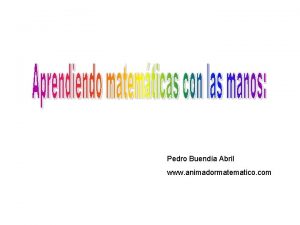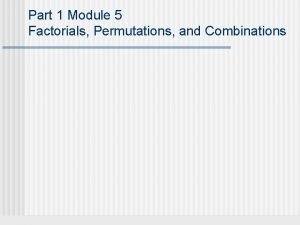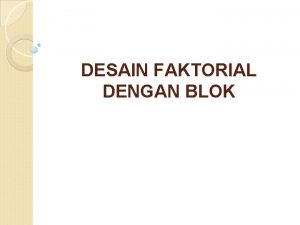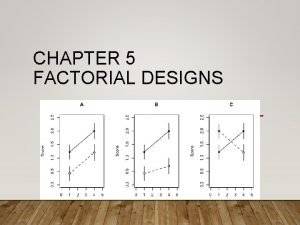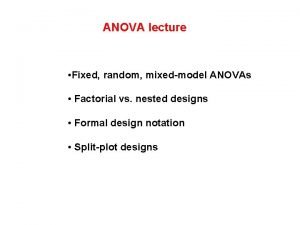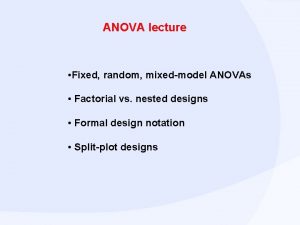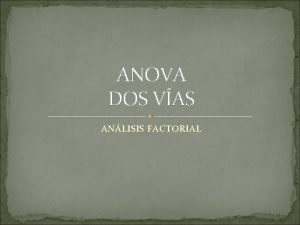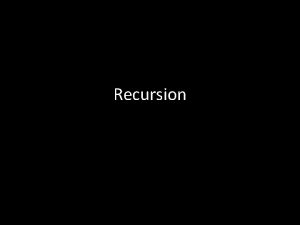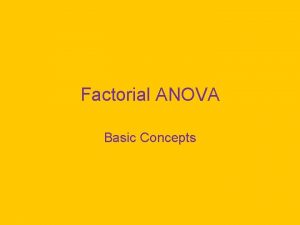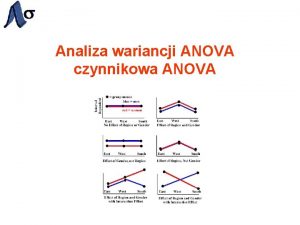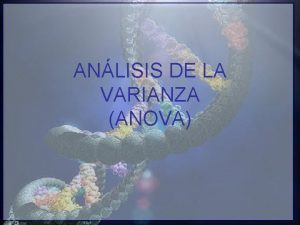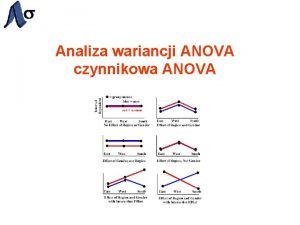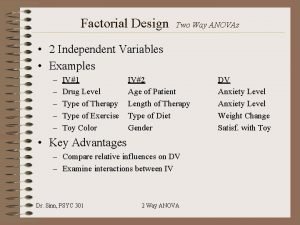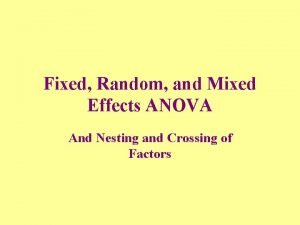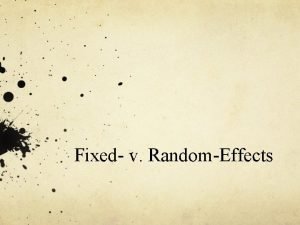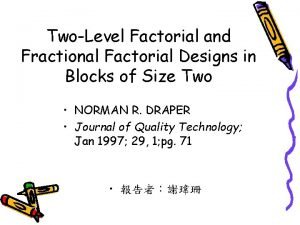ANOVA lecture Fixed random mixedmodel ANOVAs Factorial vs


























- Slides: 26

ANOVA lecture • Fixed, random, mixed-model ANOVAs • Factorial vs. nested designs • Formal design notation • Split-plot designs

Goals 1. Describe your ANOVA design to a statistician (who can then help you analyse it). 2. Recognize three common types of ANOVA designs: • • • Factorial: fixed, randomized block Nested Split-plot 3. For your reference: formulas for F tests for each

Factor – a variable of interest e. g. temperature Level – a particular value / state of a factor e. g. hot, cold In this example, temperature is a factor with two levels.

Fixed factor Either (1) The investigator chooses the levels of the factor for some purpose. Eg. Ambient CO 2 vs. double CO 2 OR (2) The levels used represent all possible levels. Eg. Biological sex: Male, female

Random factor The levels of the factor are chosen randomly from a universe of possible levels. Eg. We want to look at whether butterfly collectors differ in their diversity estimates for 4 plots. We select 5 collectors “randomly” from a village. Eg. We use three breeding lines of fruit flies as blocks in a genetics experiment. Blocks are typically random effects!

Formal notation Af 6 is a fixed factor called A with 6 levels Br 5 is a random factor called B with 5 levels

Group exercise (groups of 3) Experimental design handout Ø Write out the factors and levels using formal notation

ANOVA Example: formal notation Example 1 Ecologists: Er 10 Papers: Pf 2 Example 2: Populations: Pr 4 Herbivory: Hf 2 Example 3: Light: Lf 3 Nutrients: Nf 3 Blocks: Br 3

Fixed-effects ANOVA (Model I) • All factors are fixed Random-effects ANOVA (Model II) • All factors are random Mixed-model ANOVA (Model III) • Contains both fixed and random effects, e. g. randomized block!

Two-way factorial ANOVA How to calculate “F” Fixed effect (factors A & B fixed) Random effect (factors A & B random) Mixed model (A fixed, B random) Factor A MS Error MS A x B Factor B MS Error MS B MS A x B MS Error Ax. B MS A x B MS Error

Factorial design: All levels of one factor crossed by all levels of another factor, i. e. all possible combinations are represented. If you can fill in a table with unique replicates, it’s factorial! Ambient CO 2 Double CO 2 Pea plant Bean plant Corn plant

Nested design In this example, strain type is “nested within” fertilizer. Fertilizer is often called “group”, strain “subgroup” The nested factor is always random No fertilizer Strain A Strain B Nitrogen fertilizer Strain C Strain D Phosphorus fertilizer Strain E Strain F

Fertilizer O Strain A Strain B Strain C Strain D Strain E Strain F N P

Grand mean Variance: Group No fertilizer Strain A Strain B Nitrogen fertilizer Strain C Strain D Phosphorus fertilizer Strain E Strain F

Grand mean Variance: Group No fertilizer Nitrogen fertilizer Phosphorus fertilizer Variance: Subgroup within a group Strain A Strain B Strain C Strain D Strain E Strain F

Grand mean Variance: Group No fertilizer Nitrogen fertilizer Phosphorus fertilizer Variance: Subgroup within a group Strain A Strain B Strain C Strain D Strain E Variance: Among all subgroups Strain F

Nested ANOVA: “A” Subgroups nested within “B” Groups, with n replicates In our example, A=2, B=3 and n=2 df F Groups B-1 MS Groups MS Subgroups within groups B(A-1) MS Subgroups within groups MS Among all subgroups AB(n-1) Total ABn-1

Formal notation cont. Af 6 x Br 5 tells us that this is a factorial design with factor A “crossed” with factor B Af 6 (Br 5) tells us that this is a nested design with factor A “nested within” with factor B. In other words, A is subgroup, B is group.

Group exercise (groups of 3) Experimental design handout Ø Write out the factors and levels using formal notation

Example 1: Er 10 x Pf 2 Example 2: Pr 4 (Hf 2) Example 3: B r 3 x L f 3 x N f 3

Split plot design An experiment replicated within an experiment! 4 Main plots, e. g. greenhouses Ambient CO 2 Elevated CO 2

Split plot design An experiment replicated within an experiment! Main plot CO 2 Main plot error MS maintreat MS mainerror F

Split plot design An experiment replicated within an experiment! 4 Main plots, e. g. greenhouses Ambient CO 2 Elevated CO 2

Split plot design An experiment replicated within an experiment! 3 5 6 2 4 1 6 3 2 5 1 4 1 5 6 3 2 4 5 3 6 4 2 1 Subplots with six different nutrient concentrations

Split plot design An experiment replicated within an experiment! Subplot nutrient x CO 2 Subplot error MS subtreat MS subinteract MS suberror F F

Split plot design An experiment replicated within an experiment! Main plot CO 2 Main plot error Subplot nutrient x CO 2 Subplot error MS maintreat MS mainerror F MS subtreat MS subinteract MS suberror F F
 Factorial anova
Factorial anova Factorial anova
Factorial anova One way anova vs two way anova
One way anova vs two way anova Contoh kasus two way anova
Contoh kasus two way anova Perbedaan one way dan two way anova
Perbedaan one way dan two way anova Secondary reinforcers
Secondary reinforcers Variable interval
Variable interval Fixed order quantity
Fixed order quantity Four types of reinforcement schedules
Four types of reinforcement schedules Disadvantages of pld
Disadvantages of pld 01:640:244 lecture notes - lecture 15: plat, idah, farad
01:640:244 lecture notes - lecture 15: plat, idah, farad Random assignment vs random sampling
Random assignment vs random sampling Random assignment vs random selection
Random assignment vs random selection N factorial
N factorial 14factorial
14factorial Factorial button on calculator
Factorial button on calculator Three way factorial design
Three way factorial design 11factorial
11factorial Clojure tail recursion
Clojure tail recursion Descomposición factorial
Descomposición factorial Permutations formula
Permutations formula Factorial example
Factorial example Factorial randomized block design
Factorial randomized block design Design of experiments six sigma
Design of experiments six sigma 5 factorial
5 factorial Disinhibition
Disinhibition 27 factorial
27 factorial

